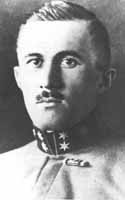World War I
Strohschneider was wounded by a bullet in the tibia early in the war, on 28 August 1914. After hospitalization, he was posted to a Guards unit, the 42nd Infantry Regiment on the Russian Front. He went into bitter winter battle at the Chryszcata Heights in the Carpathian Mountains and suffered a knee wound on 9 February 1915. He returned from hospital after this injury to command a machine gun section. On 19 September 1915, he was wounded for the third time, and captured by the Russians. He escaped to friendly lines. After convalescence, he was then invalided from the army as unfit for further service. [1] [2]
He joined the Luftfahrtruppen and was trained as an aerial observer at the Officer's Flight School at Wiener-Neustadt by March 1916. He was posted to Heinrich Kostrba's Flik 23 in the South Tyrol, where his first win went unconfirmed. More notable were his long and hazardous reconnaissance flights deep into enemy territory and his bombing missions flown through heavy antiaircraft fire. [2]
Once transferred to Flik 28 along the Isonzo, he soon trained as a pilot, returning to Wiener-Nieustadt. While attending school there, he taught student observers while also undergoing flight training. He qualified as a pilot on 30 December 1916, and received Austrian Pilot Certificate No. 596 on 30 January 1917. The new pilot was posted to Flugegeschwader I on the Isonzo line. Here he and Julius Arigi flew as fighter escort to the unit's bombers [3] and Strohschneider scored his first two victories despite a certain lack of finesse at the controls, as on 17 April 1917, he wrecked Hansa-Brandenburg D.I serial number 28.08. [4] However, this assignment saw him awarded the Silver Military Merit Medal with Swords, as well as the Military Merit Medal Third Class. [1]
Strohschneider was then transferred from his general purpose assignment to a fighter squadron at Prosecco when he was appointed second-in-command of Flik 42J. He would score nine victories during his tenure with this squadron. He would also befriend Reserve Leutnant Franz Gräser, with whom he ultimately shared seven victories. However, in an incident that demonstrated Strohschneider's belief in the rigid Austro-Hungarian class structure, he was the squadron's sole officer who did not congratulate an enlisted fellow ace on a medal awarded in October 1917. The incident did not harm Strohschneider's professional reputation; on 29 October he was commended by his superiors for his exemplary temporary command of his squadron. [5]
He was then posted to command of a fighter unit, Flik 61J on 28 December 1917, the first reserve lieutenant to do so. He was joined by his friend, Franz Gräser, at Flik 61J's field at Motta di Livenza. [6] Strohschneider also found himself simultaneously commanding a second fighter squadron while its commander Karl Nikitsch was ill. Under Strohschneider's leadership, Flik 61J undertook a wide variety of missions. It flew fighter interceptions, fighter escort missions, strafed trenches and artillery batteries, attacked enemy airfields and naval ships. They also flew night sorties. [5] Strohschneider was awarded the Order of the Iron Crown, Third Class, with War Decoration and Swords for his feats. [1]
On the night of 20 March 1918, Ernst Strohschneider took off in Phonix D.I s/n 228.36 to accompany a five plane night mission against an Italian position at Zenson di Piave. His return in the early morning hours of 21 March ended in a fatal crash. He was posthumously honored with the Knight's Cross of the Order of Leopold with War Decoration and Swords. [1]
This page is based on this
Wikipedia article Text is available under the
CC BY-SA 4.0 license; additional terms may apply.
Images, videos and audio are available under their respective licenses.
